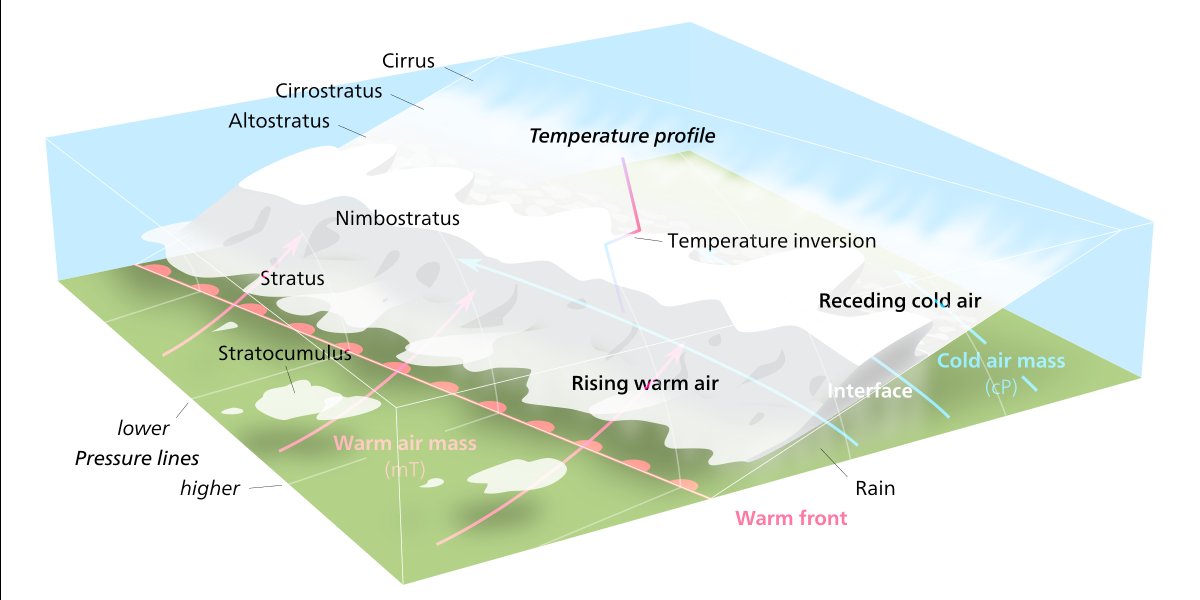#contrails
It's pretty straightforward. Burning hydrocarbon fuels produces water vapour... LOTS of it.
1.37 times the mass of the fuel burned, in fact.
An airliner will produce anywhere between 1-5kg of water vapour per SECOND in the cruise:
It's pretty straightforward. Burning hydrocarbon fuels produces water vapour... LOTS of it.
1.37 times the mass of the fuel burned, in fact.
An airliner will produce anywhere between 1-5kg of water vapour per SECOND in the cruise:

That water vapour exhausts into freezing cold air...
It is on average -56.5⁰C at the tropopause - the upper limit of the lower layer of the atmosphere where jets cruise.
How it then behaves depends entirely on hiwnmuch water vapour that air is already holding...
It is on average -56.5⁰C at the tropopause - the upper limit of the lower layer of the atmosphere where jets cruise.
How it then behaves depends entirely on hiwnmuch water vapour that air is already holding...
If the air is very dry, visible condensation may not appear at all...
If it has SOME relative humidity, the water vapour from the exhaust may initially condense out, but then re-evaporate... sometimes almost immediately, sometime after a few minutes...
If it has SOME relative humidity, the water vapour from the exhaust may initially condense out, but then re-evaporate... sometimes almost immediately, sometime after a few minutes...

If the condensed contrail doesn't immediately start to dissipate, it will freeze into microscopic ice crystals - remember, it's bloody cold up there...
Now a different criterion applies - the relative humidity with respect to ICE - which is different to that for liquid water...
Now a different criterion applies - the relative humidity with respect to ICE - which is different to that for liquid water...

Air can become 'ice supersaturated' - which means the ice has nowhere to go as it will not sublimate (directly evaporate)...
When this criterion is also met, a now-frozen contrail will persist:
When this criterion is also met, a now-frozen contrail will persist:

What happens next is largely dependent on a number of factors... just HOW ice supersaturated the air is, the amount of turbulence in that layer of the atmosphere, the local wind patterns... that hard-frozen contrail in saturated air that has nowhere to evaporate to can spread...
And eventually, it can spread out a long way, continuing to suck up additional water vapour from the surrounding air and grow, until it becomes indistinguishable from other cirrus clouds at thise altitudes: 

You can often find persistent contrails preceding a change in weather, with alot of thickening and lowering cloud... it would be easy to see the contrails as the CAUSE of this cloud, however, this isn't the case...
When a warm front is on its way in, it is the upper troposphere that will increase in relative humidity first - after all, a warm front is just a warmer, more moist airmass pushing over the top of a cooler dryer one due to their differing densities... 

The 'top edge' of the warm front - which goes up to the tropopause (remember, right where jets like to cruise) is usually 150-200 miles or so ahead of where the front passes at ground level, with increasing and thickening cloud as it approaches... 

As the front approaches it pushes more and more moisture up into the upper troposphere, increasing the relative humidity and making persistent contrails far more likely...
In fact, it ISN'T the contrails causing the conditions... itis the conditions CAUSING the contrails.
In fact, it ISN'T the contrails causing the conditions... itis the conditions CAUSING the contrails.
You can see this by looking at an atmospheric sounding.
Thebred line here is temperature, the blue line dew point (temperature at which water wapour will start to condense out). The gap between them is relative humidity (how saturated the air is):
Thebred line here is temperature, the blue line dew point (temperature at which water wapour will start to condense out). The gap between them is relative humidity (how saturated the air is):

Here you can see 96% RH at a temp -47.1⁰C, an ambient pressure of ~260mb - about 35,000ft.
The blue highlight is the -40⁰C isotherm - important as it is part of the Schmidt-Appleman Criterion.
Where RH>~70%, temp <~-40⁰C and pressure <~300mb, persistent contrails are likely
The blue highlight is the -40⁰C isotherm - important as it is part of the Schmidt-Appleman Criterion.
Where RH>~70%, temp <~-40⁰C and pressure <~300mb, persistent contrails are likely

If you want to explore the physics behind it, there are over 200 academic papers on the subject that lay it all out - I'll link some here:
journals.ametsoc.org/view/journals/…
journals.ametsoc.org/view/journals/…

For those that don't want to go cross-eyed trying to read atmospheric physics papers, here's a plain-English description:
swallowingthecamel.me/2012/06/27/che…
swallowingthecamel.me/2012/06/27/che…
And a short video explaining the formation:
• • •
Missing some Tweet in this thread? You can try to
force a refresh

 Read on Twitter
Read on Twitter



